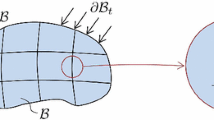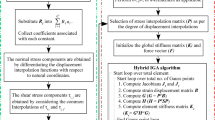Abstract
Quadratic NURBS-based discretizations of the Galerkin method suffer from volumetric locking when applied to nearly-incompressible linear elasticity. Volumetric locking causes not only smaller displacements than expected, but also large-amplitude spurious oscillations of normal stresses. Continuous-assumed-strain (CAS) elements have been recently introduced to remove membrane locking in quadratic NURBS-based discretizations of linear plane curved Kirchhoff rods (Casquero et al. in Comput Methods Appl Mech Eng 360:112765, 2022). In this work, we propose two generalizations of CAS elements (named CAS1 and CAS2 elements) to overcome volumetric locking in quadratic NURBS-based discretizations of nearly-incompressible linear elasticity. CAS1 elements linearly interpolate the strains at the knots in each direction for the term in the variational form involving the first Lamé parameter while CAS2 elements linearly interpolate the dilatational strains at the knots in each direction. For both element types, a displacement vector with \(C^1\) continuity across element boundaries results in assumed strains with \(C^0\) continuity across element boundaries. In addition, the implementation of the two locking treatments proposed in this work does not require any additional global or element matrix operations such as matrix inversions or matrix multiplications. The locking treatments are applied at the element level and the nonzero pattern of the global stiffness matrix is preserved. The numerical examples solved in this work show that CAS1 and CAS2 elements, using either two or three Gauss–Legrendre quadrature points per direction, are effective locking treatments since they not only result in more accurate displacements for coarse meshes, but also remove the spurious oscillations of normal stresses.









Similar content being viewed by others
References
Cottrell JA, Reali A, Bazilevs Y, Hughes TJR (2006) Isogeometric analysis of structural vibrations. Comput Methods Appl Mech Eng 195:5257–5296
Hughes TJR, Reali A, Sangalli G (2008) Duality and unified analysis of discrete approximations in structural dynamics and wave propagation: comparison of \( p\)-method finite elements with \(k\)-method NURBS. Comput Methods Appl Mech Eng 197:4104–4124
Hughes TJR, Evans JA, Reali A (2014) Finite element and NURBS approximations of eigenvalue, boundary-value, and initial-value problems. Comput Methods Appl Mech Eng 272:290–320
Hughes TJR, Cottrell JA, Bazilevs Y (2005) Isogeometric analysis: CAD, finite elements, NURBS, exact geometry and mesh refinement. Comput Methods Appl Mech Eng 194:4135–4195
Cottrell JA, Hughes TJR, Bazilevs Y (2009) Isogeometric analysis: toward integration of CAD and FEA. Wiley, Hoboken
Lipton S, Evans J, Bazilevs Y, Elguedj T, Hughes TJR (2010) Robustness of isogeometric structural discretizations under severe mesh distortion. Comput Methods Appl Mech Eng 199:357–373
Elguedj T, Bazilevs Y, Calo VM, Hughes TJR (2008) \(\overline{B}\) and \(\overline{F}\) projection methods for nearly incompressible linear and non-linear elasticity and plasticity using higher-order NURBS elements. Comput Methods Appl Mech Eng 197:2732–2762
Flanagan D, Belytschko T (1981) A uniform strain hexahedron and quadrilateral with orthogonal hourglass control. Int J Numer Methods Eng 17(5):679–706
Belytschko T, Ong JSJ, Liu WK, Kennedy JM (1984) Hourglass control in linear and nonlinear problems. Comput Methods Appl Mech Eng 43(3):251–276
Reese S, Küssner M, Reddy BD (1999) A new stabilization technique for finite elements in non-linear elasticity. Int J Numer Methods Eng 44(11):1617–1652
Reese S, Wriggers P, Reddy B (2000) A new locking-free brick element technique for large deformation problems in elasticity. Comput Struct 75(3):291–304
Nagtegaal JC, Parks DM, Rice J (1974) On numerically accurate finite element solutions in the fully plastic range. Comput Methods Appl Mech Eng 4(2):153–177
Hughes TJR (1980) Generalization of selective integration procedures to anisotropic and nonlinear media. Int J Numer Methods Eng 15(9):1413–1418
Hughes TJR (1977) Equivalence of finite elements for nearly incompressible elasticity. J Appl Mech 44(1):181–183
Malkus DS, Hughes TJR (1978) Mixed finite element methods-reduced and selective integration techniques: a unification of concepts. Comput Methods Appl Mech Eng 15(1):63–81
Hughes TJR, Malkus DS (1981) A general penalty/mixed equivalence theorem for anisotropic, incompressible finite elements. In: Atluri SN (ed) Hybrid and mixed finite element methods. Wiley, Hoboken, pp 487–496
Wilson E, Taylor R, Doherty W, Ghaboussi J (1973) Incompatible displacement models. In: Fenves SJ (ed) Numerical and computer methods in structural mechanics. Academic Press, New York, pp 43–57
Simo JC, Rifai M (1990) A class of mixed assumed strain methods and the method of incompatible modes. Int J Numer Methods Eng 29(8):1595–1638
Simo JC, Armero F (1992) Geometrically non-linear enhanced strain mixed methods and the method of incompatible modes. Int J Numer Methods Eng 33(7):1413–1449
Glaser S, Armero F (1997) On the formulation of enhanced strain finite elements in finite deformations. Eng Comput 14:759–791
Kasper EP, Taylor RL (2000) A mixed-enhanced strain method: part I: geometrically linear problems. Comput Struct 75(3):237–250
Kasper EP, Taylor RL (2000) A mixed-enhanced strain method: part II: geometrically nonlinear problems. Comput Struct 75(3):251–260
Auricchio F, da Veiga LB, Lovadina C, Reali A, Sangalli G (2007) A fully “locking-free’’ isogeometric approach for plane linear elasticity problems: a stream function formulation. Comput Methods Appl Mech Eng 197(1–4):160–172
Elguedj T, Hughes TJR (2014) Isogeometric analysis of nearly incompressible large strain plasticity. Comput Methods Appl Mech Eng 268:388–416
Antolin P, Bressan A, Buffa A, Sangalli G (2017) An isogeometric method for linear nearly-incompressible elasticity with local stress projection. Comput Methods Appl Mech Eng 316:694–719
Bressan A (2011) Isogeometric regular discretization for the Stokes problem. IMA J Numer Anal 31(4):1334–1356
Bressan A, Sangalli G (2013) Isogeometric discretizations of the Stokes problem: stability analysis by the macroelement technique. IMA J Numer Anal 33(2):629–651
Taylor R (2011) Isogeometric analysis of nearly incompressible solids. Int J Numer Methods Eng 87(1–5):273–288
Cardoso RP, CesardeSa JMA (2012) The enhanced assumed strain method for the isogeometric analysis of nearly incompressible deformation of solids. Int J Numer Methods Eng 92(1):56–78
Moutsanidis G, Li W, Bazilevs Y (2021) Reduced quadrature for FEM, IGA and meshfree methods. Comput Methods Appl Mech Eng 373:113521
Li W, Moutsanidis G, Behzadinasab M, Hillman M, Bazilevs Y (2022) Reduced quadrature for finite element and isogeometric methods in nonlinear solids. Comput Methods Appl Mech Eng 399:115389
Adam C, Hughes TJR, Bouabdallah S, Zarroug M, Maitournam H (2015) Selective and reduced numerical integrations for NURBS-based isogeometric analysis. Comput Methods Appl Mech Eng 284:732–761
Nagy AP, Benson DJ (2015) On the numerical integration of trimmed isogeometric elements. Comput Methods Appl Mech Eng 284:165–185
Breitenberger M, Apostolatos A, Philipp B, Wüchner R, Bletzinger KU (2015) Analysis in computer aided design: nonlinear isogeometric B-Rep analysis of shell structures. Comput Methods Appl Mech Eng 284:401–457
Leidinger L, Breitenberger M, Bauer A et al (2019) Explicit dynamic isogeometric B-Rep analysis of penalty-coupled trimmed NURBS shells. Comput Methods Appl Mech Eng 351:891–927
Buffa A, Puppi R, Vázquez R (2020) A minimal stabilization procedure for isogeometric methods on trimmed geometries. SIAM J Numer Anal 58(5):2711–2735
Wei X, Marussig B, Antolin P, Buffa A (2021) Immersed boundary-conformal isogeometric method for linear elliptic problems. Comput Mech 68(6):1385–1405
Antolin P, Wei X, Buffa A (2022) Robust numerical integration on curved polyhedra based on folded decompositions. Comput Methods Appl Mech Eng 395:114948
Toshniwal D, Speleers H, Hughes TJR (2017) Smooth cubic spline spaces on unstructured quadrilateral meshes with particular emphasis on extraordinary points: geometric design and isogeometric analysis considerations. Comput Methods Appl Mech Eng 327:411–458
Casquero H, Wei X, Toshniwal D et al (2020) Seamless integration of design and Kirchhoff–Love shell analysis using analysis-suitable unstructured T-splines. Comput Methods Appl Mech Eng 360:112765
Hiemstra RR, Shepherd KM, Johnson MJ, Quan L, Hughes TJR (2020) Towards untrimmed NURBS: CAD embedded reparameterization of trimmed B-rep geometry using frame-field guided global parameterization. Comput Methods Appl Mech Eng 369:113227
Wei X, Li X, Qian K, Hughes TJR, Zhang YJ, Casquero H (2022) Analysis-suitable unstructured T-splines: multiple extraordinary points per face. Comput Methods Appl Mech Eng 391:114494
Shepherd KM, Gu XD, Hughes TJR (2022) Isogeometric model reconstruction of open shells via Ricci flow and quadrilateral layout-inducing energies. Eng Struct 252:113602
Shepherd KM, Gu XD, Hughes TJR (2022) Feature-aware reconstruction of trimmed splines using Ricci flow with metric optimization. Comput Methods Appl Mech Eng 402:115555
Toshniwal D (2022) Quadratic splines on quad-tri meshes: construction and an application to simulations on watertight reconstructions of trimmed surfaces. Comput Methods Appl Mech Eng 388:114174
Wen Z, Faruque MS, Li X, Wei X, Casquero H (2023) Isogeometric analysis using G-spline surfaces with arbitrary unstructured quadrilateral layout. Comput Methods Appl Mech Eng 408:115965
Fahrendorf F, Morganti S, Reali A, Hughes TJR, De Lorenzis L (2020) Mixed stress-displacement isogeometric collocation for nearly incompressible elasticity and elastoplasticity. Comput Methods Appl Mech Eng 369:113112
Morganti S, Fahrendorf F, De Lorenzis L, Evans JA, Hughes TJR, Reali A (2021) Isogeometric collocation: a mixed displacement-pressure method for nearly incompressible elasticity. CMES Comput Model Eng Sci 129(3):1125–1150
Casquero H, Golestanian M (2022) Removing membrane locking in quadratic NURBS-based discretizations of linear plane Kirchhoff rods: CAS elements. Comput Methods Appl Mech Eng 399:115354
Golestanian M, Casquero H (2023) Extending CAS elements to remove shear and membrane locking from quadratic NURBS-based discretizations of linear plane Timoshenko rods. Int J Numer Methods Eng 124(18):3997–4021
Casquero H, Mathews KD (2023) Overcoming membrane locking in quadratic NURBS–based discretizations of linear Kirchhoff–Love shells: CAS elements. Comput Methods Appl Mech Eng 417:116523
Hughes TJR (2012) The finite element method: linear static and dynamic finite element analysis. Courier Corporation, Chelmsford
Dalcin L, Collier N, Vignal P, Côrtes A, Calo VM (2016) PetIGA: a framework for high-performance isogeometric analysis. Comput Methods Appl Mech Eng 308:151–181
Balay S, Adams MF, Brown J, et al (2014) PETSc web page. http://www.mcs.anl.gov/petsc
Cook R, Malkus DS, Plesha M, Witt RJ (2007) Concepts and applications of finite element analysis. Wiley, Hoboken
CesardeSa JMA, Natal Jorge RM (1999) New enhanced strain elements for incompressible problems. Int J Numer Methods Eng 44(2):229–248
Chavan KS, Lamichhane BP, Wohlmuth BI (2007) Locking-free finite element methods for linear and nonlinear elasticity in 2D and 3D. Comput Methods Appl Mech Eng 196(41–44):4075–4086
Schröder J, Wick T, Reese S et al (2021) A selection of benchmark problems in solid mechanics and applied mathematics. Arch Comput Methods Eng 28:713–751
Dolbow J, Belytschko T (1999) Volumetric locking in the element free Galerkin method. Int J Numer Methods Eng 46(6):925–942
Huerta A, Fernández-Méndez S (2001) Locking in the incompressible limit for the element-free Galerkin method. Int J Numer Methods Eng 51(11):1361–1383
Nguyen TH, Hiemstra RR, Schillinger D (2022) Leveraging spectral analysis to elucidate membrane locking and unlocking in isogeometric finite element formulations of the curved Euler–Bernoulli beam. Comput Methods Appl Mech Eng 388:114240
Acknowledgements
H. Casquero and M. Golestanian were partially supported by Ansys Inc. and the NSF Grant CMMI-2138187.
Author information
Authors and Affiliations
Corresponding author
Additional information
Publisher's Note
Springer Nature remains neutral with regard to jurisdictional claims in published maps and institutional affiliations.
Rights and permissions
Springer Nature or its licensor (e.g. a society or other partner) holds exclusive rights to this article under a publishing agreement with the author(s) or other rightsholder(s); author self-archiving of the accepted manuscript version of this article is solely governed by the terms of such publishing agreement and applicable law.
About this article
Cite this article
Casquero, H., Golestanian, M. Vanquishing volumetric locking in quadratic NURBS-based discretizations of nearly-incompressible linear elasticity: CAS elements. Comput Mech (2023). https://doi.org/10.1007/s00466-023-02409-5
Received:
Accepted:
Published:
DOI: https://doi.org/10.1007/s00466-023-02409-5




